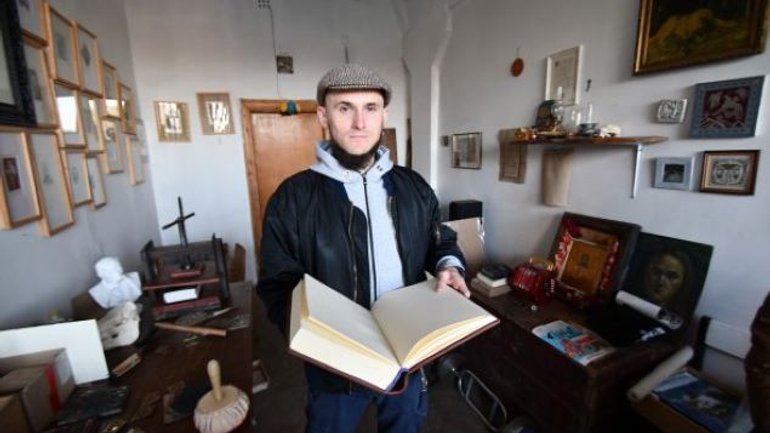Ukrainian artist recreates a medieval book for Patriarch Bartholomew

He told you about the details to Gazeta.ua.
"I recreate books, not restore them. For example, somewhere in a museum in Belgium or France, there is a code dated the XV century. The client wants the same thing with or without repeating the font part. If I don't know certain subtleties, I explore this copy more meaningfully and reproduce it completely using the technologies of the Middle Ages."
Valentyn Kolontai uses different book block sewing techniques, depending on the period.
"If this is the time of Byzantium in the Middle Ages, then I sew with an Alpha Loop or chain. If Gothic, then this is sewing on leather cords or belts - the so-called fishbone. The braided tail-band that fastens the book block (a set of notebooks or sheets, a book without a cover - Gazeta.ua) on modern books replaces a piece of fabric that imitates it. And in medieval codices, it was a decorative detail that additionally strengthened the book block itself. He also uses the techniques of blind embossing on leather, foil stamping, hot enamel, hand printing elements and others," the master shares.
He makes the metal book decorations himself. If complex, he involves jewellers.
"There are no problems with the materials. You can order everything by mail. You can buy any paper. I make goat or sheep parchment myself. Any kind of leather for frames decoration is also available," says the artist.
A stationery knife, needle, or thread are the tools used to create a book block.
"I use a variety of knives for processing leather, clichés and tiles for heating it, hammers, presses for sizing the book block, creating hot stamping. The most difficult moments of creating a book are in your head. Every subsequent project requires processes that I haven't done yet. For example, I didn't do foil stamping before, but here it is necessary. And so I think, I have no practice, now I will take it and spoil it. Then you just need to organize and do something. If it does not work out – redo it. Technically, this case is not super-complicated," explains Valentyn.
The book was costly in the Middle Ages, especially in the early period of the XII-XIII centuries.
"They were made mainly in Monastery workshops. One master or several worked on one code. From parchment, he created a book block, made a frame himself. And before that, I could fill in the font part on my own. Over time, when cities gained strength, universities appeared, and separate workshops appeared that divided the entire process. At that time, many people were already working on making one book. Someone made parchment, other miniatures. Someone else wrote fonts, sewed, made frames. The further it went, the cheaper the book became, turning from a status book to a more utilitarian one. It became accessible not only to aristocrats but also to Burghers and students. Secular texts have emerged, not just religious ones."
Valentyn Kolontai admired the medieval era from childhood: "the knights and ladies impressed me a lot. Subsequently, I took an interest in weapons of that period, book reconstructions. I understand that I took it stereotypically. After all, the Middle Ages had their own dirt, pain and trials. Now, the more I know what it really was like, the more my love grows. This period is like the childhood of humanity. Many modern processes are rooted from there, where they arise and develop," he explains.
Etching is one of the manual printing techniques used by the master.
"I make a printing plate, engrave it with a needle on copper or brass, etch it in acid," he describes the process. - I take it out of the acid, wash it with a solvent, rub the paint, remove the excess, put moistened paper on top and roll it on the machine. It has two metal shafts, and when a mould with paper passes between them, it takes the paint on itself, and we have an impression. Nothing has changed in this technology from the XV century to the present day. You can make one print using one form, or you can print 200, for example."
The master has enough customers, he says:
"What I do is popular and very niche. Collectors order printed graphics and serious projects. There are people who do not know what they are doing but want such a book. There are those who are interested in history and religion. They often order it for a gift, especially on holidays."
Works by Valentyn Kolontai were presented to World Patriarch Bartholomew and American model Paris Hilton.
"I made a guest book for the Grand Hotel in Lviv, stored at the reception. Customers gave it to Paris Hilton for the opening of the renovated institution, she came to Lviv in 2018," the artist said.
For Ecumenical Patriarch Bartholomew, a delegation from the Lviv City Council ordered an album with a medieval theme, recalls Valentyn:
"They pasted letters from children and their photos there. I made a leather frame, embossed elements based on miniatures of the Galician Gospel. Then they brought me a photo of Bartholomew flipping through the album."









